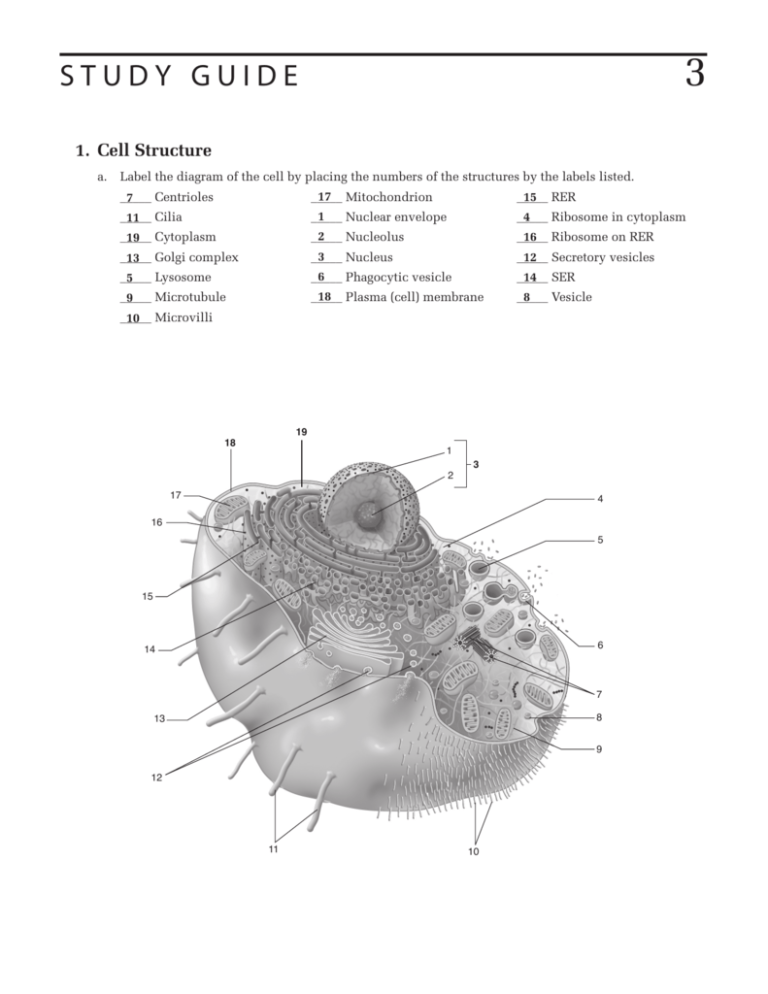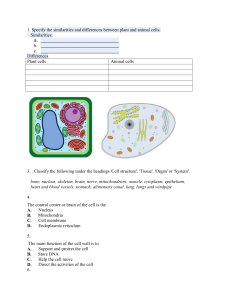study guide - SCF Faculty Site Homepage
advertisement

3 STUDY GUIDE 1. Cell Structure a. Label the diagram of the cell by placing the numbers of the structures by the labels listed. _____ Centrioles 7 17 Mitochondrion _____ _____ 15 RER _____ 11 Cilia 1 _____ Nuclear envelope _____ Ribosome in cytoplasm 4 _____ 19 Cytoplasm 2 _____ Nucleolus _____ 16 Ribosome on RER _____ 13 Golgi complex 3 _____ Nucleus _____ 12 Secretory vesicles _____ Lysosome 5 6 _____ Phagocytic vesicle _____ 14 SER _____ Microtubule 9 18 Plasma (cell) membrane _____ _____ Vesicle 8 _____ 10 Microvilli 19 18 1 2 3 17 4 16 5 15 6 14 7 8 13 9 12 11 10 b. Write the terms that match the phrases in the spaces at the right. 1) Endoplasmic reticulum with ribosomes. ____________________________________________ RER 2) Forms cytoskeleton (two answers). ____________________________________________ Microfilament ____________________________________________ Microtubule 3) Packages materials for export from cell. ____________________________________________ Golgi apparatus 4) Sites of protein synthesis. ____________________________________________ Ribosomes 5) Composed of DNA and protein. ____________________________________________ Chromosomes 6) Intranuclear site of rRNA synthesis. ____________________________________________ Nucleolus Mitochondria 7) Sites of cellular respiration. ____________________________________________ 8) Controls movement of materials between nucleus and cytoplasm. ____________________________________________ Nuclear envelope ____________________________________________ 9) Endoplasmic reticulum without ribosomes. SER ____________________________________________ 10) Vesicles of digestive enzymes. Lysosomes 11) Provides motility for sperm. ____________________________________________ Flagellum 12) Short cylinders formed of microtubules. ____________________________________________ Centrioles 13) Semi-liquid around organelles. ____________________________________________ Cytoplasm 14) Short, hairlike projections that move substances across cell surfaces. ____________________________________________ Cilia 15) Controls movement of materials into and out of the cell. ____________________________________________ Cell membrane 16) Sites of aerobic cellular respiration. ____________________________________________ Mitochondria 17) Contains chromosomes. ____________________________________________ Nucleus 18) Forms channels for material transport in the cytoplasm. ____________________________________________ Endoplasmic reticulum 19) Molecule determining inheritance. ____________________________________________ DNA 20) Organelle controlling cell functions. ____________________________________________ Nucleus 2. Transport Through Plasma Membranes a. Match the terms and phrases. Diffusion Osmosis Phagocytosis Pinocytosis 1) Diffusion of water. ____________________________________________ Osmosis 2) Engulfment of small particles. ____________________________________________ Phagocytosis 3) Engulfment of liquid droplets. ____________________________________________ Pinocytosis 4) Movement of molecules from an area of higher ____________________________________________ Diffusion concentration to areas of lower concentration. ____________________________________________ Diffusion; Osmosis 5) Results from random molecular movement. b. Identify the transport processes as either active (A) or passive (P). A By carrier proteins P Osmosis _____ _____ P Diffusion _____ A Phagocytosis _____ c. A Pinocytosis _____ A Exocytosis _____ Consider the solutions below that are separated by a selectively permeable membrane. Use arrows to show the direction of diffusion. In 1, show the direction of water movement. In 2, show the direction of solute movement. 1) A 10% protein solution ← B 2) 5% protein solution 56 A 10% salt solution → B 5% salt solution B 3) In 1, which solution is hypotonic? ___________________________________________________________ A 4) In 2, which solution is hypertonic? ___________________________________________________________ 5) Describe what happens when a human cell is placed in a hypotonic solution. ___________________ Water enters the cell causing it to swell and finally burst. 3. Cellular Respiration a. Write the summary equation for the cellular respiration of glucose. Words may be used instead of chemical formulas. Glucose oxygen → carbon dioxide water energy b. Completion Carbon dioxide ____________________________________________ 1) List the products of cellular respiration. Water ______________________________________________________________________________________________ Energy Glucose 2) The source of energy captured in ATP. ________________________________________________________ c. Explain why cellular respiration is a continuous process. ________________________________________ A continuous supply of ATP is required to _____________________________________________________________________________________________ provide energy for the metabolic processes of life. _____________________________________________________________________________________________ 4. Protein Synthesis Completion 1) The genetic code consists of the sequence of bases in ________ molecules. 2) The genetic code is transcribed to the sequence of bases in _____ molecules. 3) Molecule that carries instructions for protein synthesis to ribosomes. 4) Molecule that carries amino acids to ribosome for addition to amino acid chain. 5) Small molecules that join to form a protein during translation. DNA ____________________________________________ mRNA ____________________________________________ mRNA ____________________________________________ tRNA ____________________________________________ Amino acids ____________________________________________ 5. Cell Division a. Indicate the type of cell division described by the statements. 1) Provides new cells for growth and repair. ____________________________________________ Mitotic cell division 2) Forms sperm and ova. ____________________________________________ Meiotic cell division 3) Daughter cells have same chromosome number and composition as parent cell. ____________________________________________ Mitotic cell division 4) Daughter cells have half the number of chromosomes as the parent cell. ____________________________________________ Meiotic cell division b. Select the phase of the cell cycle described by the statements. Interphase Prophase Metaphase Anaphase Telophase 1) Division of the cytoplasm. ____________________________________________ Telophase 2) Replication of chromosomes. ____________________________________________ Interphase 3) Chromosomes appear as threadlike bodies. ____________________________________________ Prophase 4) Chromatids move toward ends of spindle. ____________________________________________ Anaphase 57 c. 5) New nuclei start to form. ____________________________________________ Telophase 6) Occupies most of cell cycle. ____________________________________________ Interphase 7) Chromosomes line up at equator of spindle. ____________________________________________ Metaphase 8) Cell performs its normal functions. ____________________________________________ Interphase Human body cells have 46 chromosomes. How many chromosomes are in daughter cells formed by mitotic cell division? 46 d. Write the names of the mitotic phases in the spaces provided and place the numbers of the cell parts in the spaces by the correct label. 4 Chromosome 1 _____ _____ Centrioles _____ Centromere _____ 5 Chromatid 3 2 Spindle fiber _____ 3 5 5 1 1 2 3 2 7) Prophase 6) Metaphase 5 4 1 1 2 9) Telophase 8) Anaphase 6. Clinical Applications When you drink a glass of water, how does the water enter the blood? _____________________________ By osmosis Why does this occur? _________________________________________________________________________ Water concentration in the blood is less than that in the digestive tract. b. Explain why a chemical therapy drug that disrupts formation of spindle fibers kills cancerous cells. It prevents normal cell division. _____________________________________________________________________________________________ a. _____________________________________________________________________________________________ 58






